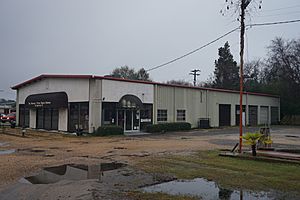National Voting Rights Museum facts for kids
The National Voting Rights Museum and Institute is an important museum in Selma, Alabama. It was created in 1991 and opened its doors in 1993. This museum celebrates and remembers the brave people who worked for the right to vote for all Americans. It focuses on the events leading up to the Selma to Montgomery marches in 1965 and the passing of the Voting Rights Act that same year. The museum also honors those who fought for African-American Voting Rights and Women's suffrage, which is the right for women to vote. The museum's goal is to show how the idea of voting rights has grown in America since 1776. Faya Ora Rose Touré and Marie Foster were the founders of this special museum.
The museum is located very close to the Edmund Pettus Bridge. On March 7, 1965, a group of people began a march from Selma to Montgomery to demand voting rights. When they crossed this bridge, they were attacked by police and state troopers. This event became known as "Bloody Sunday". News of this violence was shown on TV and in newspapers across the country, making many people angry and upset. After this, President Lyndon B. Johnson provided federal protection for the marchers. A court also ruled that they had the right to march. On March 21, thousands of people, both Black and white, started the march again from Selma. They reached Montgomery several days later, with about 25,000 marchers joining them to ask for their constitutional right to vote. Later that summer, the Voting Rights Act of 1965 was passed by Congress and signed into law by the President. This law helped protect the voting rights of all citizens.
Contents
Museum Exhibits and Collections
The National Voting Rights Museum has several rooms and areas where visitors can learn about history.
Footprints to Freedom
This room features special molded footprints of some of the activists who took part in the Selma to Montgomery marches. It helps visitors feel connected to the people who walked for freedom.
Women's Right to Vote
This area is dedicated to the "Women's Suffrage Room." It honors the important contributions of African-American women and other women who worked hard to secure voting rights for all women in the United States.
The Selma Room
Also known as the "Marie Foster" room, this exhibit displays items from the social movements. You can see old voting records, clothes worn by people who were hurt during the march, and other artifacts that tell the story of these important times.
Sharing Memories
The museum also has a room where people who participated in the 1960s marches can leave their personal messages and share their memories. This allows their stories to be preserved for future generations.
Iconic Photography
A large image from the Selma to Montgomery march is also featured. This iconic photograph was taken by Look magazine photographer James Karales. It captures a powerful moment from the historic march.
More to Explore
- Dr. Martin Luther King's 1957 Give Us the Ballot speech
- Voting rights in the United States
- Birmingham Civil Rights Institute
- Civil rights movement in popular culture
- National Civil Rights Museum
- Woman Suffrage Procession
- Declaration of Sentiments
- Seneca Falls Convention
- Women's suffrage in the United States
See also
 In Spanish: Museo e Instituto Nacional del Derecho al Voto para niños
In Spanish: Museo e Instituto Nacional del Derecho al Voto para niños


